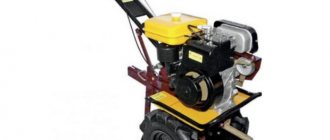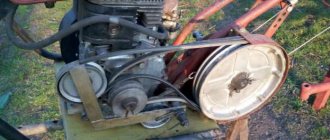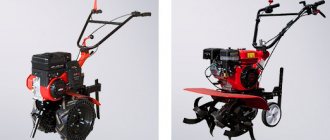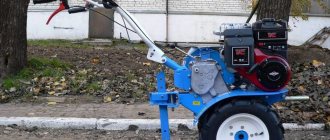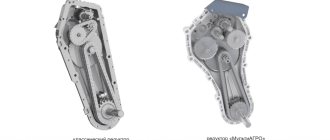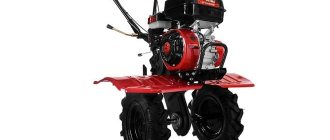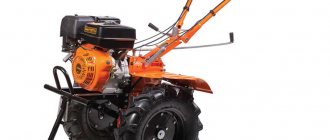Motoblocks "Cascade" are produced in the city of Perm. Their manufacturer is OJSC "Reductor-PM" (PM - Perm Motors), part of the enterprise "Aviation Gearboxes and Transmissions - PM".
This plant, part of the Russian Military-Industrial Complex, dates back to 1951, and specializes in the production and after-sales service of gearboxes and transmissions for domestically produced helicopters.
Pavilion of JSC "Reductor-PM" at the international exhibition of the helicopter industry "HeliRussia".
Walk-behind tractors appeared on the company’s product list in 1995 and became one of the few concrete manifestations of the then fashionable term “conversion” (i.e., the transition of the military industry to the production of purely civilian products).
Scope of application of walk-behind tractors "Cascade"
The main function of the Cascade walk-behind tractor is pre-sowing tillage. Complete with appropriate mounted implements, the walk-behind tractor is designed for surface plowing, loosening and soil cultivation; leveling areas intended for sowing. In the future, “Cascade” will be useful for hilling crop plants and inter-row cultivation.
In addition, "Cascade" walk-behind tractors successfully work with the widest range of additional attachments - various cutters, hillers, walk-behind shovels, diggers, and trolley trailers. Attachments are attached to the walk-behind tractor using special “metal fingers”, which ensure good reliability and sufficient rigidity of the hitch.
The list of drive equipment available for use with Cascades includes: rotary snow blowers, water pumps, mowers, mechanical potato planters, and feed crushers. In these cases, the supply of useful force is carried out from the power plant. The drive equipment is installed in front of the walk-behind tractor and operates via an additional belt drive.
Design Features
The Cascade walk-behind tractor consists of four main elements: engine, transmission, chassis and controls. The chassis also includes the metal tubular frame of the walk-behind tractor with the wheels attached to it. An important feature of the “Cascade” is the ability to change its track, that is, the inter-wheel space, during operation.
The wheels on these walk-behind tractors are used both rubber pneumatic and rubber cast, as well as weighted metal ones. You can use the Cascade walk-behind tractor without wheels - with cultivator cutters. The cultivator for "Cascade" - "KMB 1.002.000" - has a diameter of 350 mm and provides rotary cultivation of the soil to a depth of 20 cm, with a working width of 45 cm (when installing two cutters) and up to 93 cm (when installing four cutters).
The function of transmitting torque from the engine to the wheels is performed by the walk-behind tractor transmission. It consists of a clutch, gearbox and chain reducer. These individual transmission elements are installed on Cascade walk-behind tractors, both individually and in a single unit. Other operational functions of the walk-behind tractor transmission are assistance in adjusting the speed of work and ensuring its turns while moving along the work area.
Any of the internal combustion engines on the Cascade walk-behind tractors - gasoline, carburetor, single-cylinder, four-stroke, air-cooled. Ignition is electronic non-contact. Spark plug - type “A11-1 OST 37.003.081-98”.
The engine is started using a manual starter with a pull cord. The noise level at the walk-behind tractor operator's workplace is, according to the manufacturer, 89 dBA. The vibration level on the controls (local vibration) does not exceed 135 dBA.
Over the years of production, they have tried to install on this equipment, with similar technical characteristics, both domestic engines produced in-house by the Perm plant, and Chinese “Briggs and Stratton”, “Honda”. (Yes, “Briggs & Stratton” is an American-Japanese company, but engines for walk-behind tractors of these brands are made in China). Gradually, Russian-made engines became a thing of the past, and the “Cascades” of recent years of production are all equipped with Chinese “engines”.
The main causes of breakdowns - why doesn’t the walk-behind tractor start?
The "Cascade" walk-behind tractor, like any gasoline walk-behind tractor, sometimes may not start or may not start on the first try. Possible causes of this problem could be:
- too low temperature (excessive cooling of engine, fuel);
- small amount of fuel, insufficient to turn on and operate;
- low or no oil level;
- incorrect assembly;
- clogged carburetor jets;
- oxidation of contacts in the electric starter;
- The spark plug is faulty or the spark plug needs to be cleaned;
- wire insulation is broken;
- low fuel quality
do not violate the recommendations for fuels and lubricants! This will accelerate wear on the piston group and the engine as a whole.
Engines of the walk-behind tractor "Cascade"
The domestically produced “DM-66” and “DM-68” engines are sleeved single-cylinder OHV engines with overhead valves. Built-in automatic decompressor ensures low starting effort. The working volume of the DM-66 and DM-68 engines is 317 cubic centimeters. These engines run on any gasoline - AI-80, AI-92, AI-95.
The oil sump volume of the DM-66 and DM-68 engines is 1.4 liters. The orientation of the crankshaft is horizontal. The cylinder diameter is 76 millimeters. The maximum torque is 14.2 N.m. Overall dimensions – 45x41x43 cm. Weight – 28 kg. Average fuel consumption is within two liters per hour.
Briggs&Stratton engines of the INTEK I/C and Vanguard OHV series, also single-cylinder, of a similar design to the DM, have a displacement of 208 cubic centimeters and a rated power of 4.8 kW (6.5 hp). The cylinder diameter is 68 mm. Maximum torque – 12.6 N.m. Overall dimensions – 32x38x35 cm.
It is characteristic that the power indicators, according to the official website.
Many, not unreasonably, consider the best of the Cascade walk-behind tractors to be those equipped with a Honda engine. And in fact, the Honda GH-200 engine is perhaps the most common “engine” in the world of walk-behind tractors – both domestic and Asian-made; It has been produced for decades and has an almost impeccable reputation.
The Honda GC-200 motor has a really high operating efficiency and slow wear of parts. It also features lower fuel consumption - not 2, but 1.7 or even 1.5 liters of gasoline per hour on average. The working volume of the Honda engine is 196 cubic centimeters; maximum power – 6.5 horsepower (at 3600 rpm). Cylinder diameter – 68 mm; maximum torque – 12.4 N.m. Overall dimensions – 32x38x35 cm.
In recent years, the market has been dominated by the version of the Cascade walk-behind tractor, equipped with a cheaper analogue of the Honda GC-200 engine - also a Chinese-made Lifan engine, model Lifan 168F-2.
Change of oil
It is very easy to change the engine oil yourself, without the involvement of specialists. First, unscrew the hole cap to drain the old used grease. Pour the oil prepared in advance through the neck to the required level (approximately 600 grams). As a rule, the filling crankcase has a slight inclination, which helps to avoid overfilling the lubricant. Then screw the lid on and you can use the unit again.
Tags : Chinese, or, case, main, change, worth, mb, running-in, own, pretty, motor, term, features, do, done, people, tractor, read, often, long, hard, Russian, located, owner, refers, beginning, quantity, huge, removal, is carried out, mole, screwdrivers, actions, probe, measuring, similar, several, block, necessary, gears, completely, perform, came out, most, starts, cultivator, purchases, 168f, fundamentally, properties
Transmission and chassis of the "Cascade" walk-behind tractor
The clutch of the "Cascade" walk-behind tractors is belt-type. The clutch mechanism operates on the basis of belt tension of a V-belt type transmission. Gearbox (two types are used, and “005.45.7530” on this walk-behind tractor - chain type, two-speed
The manufacturer notes that the gearbox on the Cascade walk-behind tractor is reinforced, its output shaft is mounted on large-diameter bearings. This ensures high resistance of the mechanisms to vibrations and shocks.
Chain reducer of the "Cascade" walk-behind tractor.
As standard, “Cascade” walk-behind tractors are equipped with pneumatic tires 4.00-10, model TU 38.304-13-13-92; or cast, massive, with channels on the sides, 5.00L-12, model F-232 TU 38.304-13-05-92.
Attachments for the "Cascade" walk-behind tractor
- cutters that allow you to cultivate the land on a strip with a width of 45 to 93 centimeters. If the land does not belong to the category of virgin or particularly hard soils, then it makes sense to add two additional cutters to the two standard cutters, more than doubling the strip of land being simultaneously cultivated.
- hiller. Very convenient and useful equipment, the value of which will be appreciated by anyone who has tried it in action. It not only destroys weeds in the inter-row space, but also adds soil to the stems and roots of cultivated plants, helping them develop and grow.
- flat cutter It not only loosens the soil, but also crushes the roots of weeds, reducing labor costs for further weeding of the area.
- trailer-trolley. Of course, the speed of movement of the walk-behind tractor is very low, but, in any case, it is better to transport bags of potatoes or other heavy or dirty cargo in a cart, rather than dragging them “on your hump.” The same thing - construction waste, various tools and materials. The trailer is designed for a load of up to 600 kilograms.
- feed crusher Eliminates the need to take grain to the mill to grind it into crushed grain. It is convenient and reasonable to prepare crushed porridge for pigs and other livestock right in your barnyard.
- mower. Anyone who has tried to mow with a regular scythe and prepare hay for the winter to feed even just one cow and calf knows what a long and difficult work it is. The mower reduces labor costs and time for making hay several times.
- water pump. If there is a river or other body of water near the garden, then why not stretch a hose there and install a pump. Especially if there are interruptions in the water supply in the summer. The Cascade walk-behind tractor will provide such a strong and stable water pressure that watering the garden will take very little time. You just need to stock up on a special sprinkler attachment for the hose so that it doesn’t wash away the soil along with the cultivated plants.
- snow blower. Clearing snowdrifts after heavy snowfall with a shovel is pleasant only for the first 10-15 minutes of this work. With the help of a walk-behind tractor, the process will go disproportionately faster and more efficiently.
- potato planter and digger. Villagers will confirm that while planting potatoes with an ordinary shovel is not the most labor-intensive task, then digging them up is already hard and persistent work. More than half of the labor costs, subject to the use of appropriate equipment, will be transferred to the “metal shoulders” of the walk-behind tractor.
What kind of oil to fill
For high-quality engine operation, you need to correctly select the oil according to the SAE classification. It is necessary to strictly follow the instructions for the walk-behind tractor. Lubrication depends on the type of fuel the unit is fueled with. When operating in different seasons, lubricants of different viscosities are used.
In summer, semi-synthetic oil SAE 30 5w30 is used. In winter, a lubricant consisting entirely of synthetic materials 0w40 is used.
This is interesting: do-it-yourself repair of the Cascade walk-behind tractor engine.
You should not skimp on the quality of the oil, since it determines the efficiency of work and the duration of the process without breakdowns.
Brief overview of modifications. How to decipher factory indexes
Over the years of production, Reductor-PM OJSC has brought to the market so many modifications of the Cascade walk-behind tractor that, at first glance, it seems that there are too many of them and one can get confused in them. However, it is not. In fact, it's simple. You just need to “read” the alphabetic and digital designations in the factory indices of these walk-behind tractors.
MB6 is a model with a domestic engine (“DM66” or “DM68”). MB61 is a model with a foreign-made engine (“Briggs&Stratton” or “Honda”).
01 – steering rod. 02 – rotating steering column, which allows you to adjust the position of the steering wheel in the vertical and horizontal planes.
In the 04 series gearbox, the gearbox output shaft is mounted on needle bearings. In gearboxes of the 05, 06, 07 series, the gearbox output shaft is mounted on ball bearings.
Also, the gearboxes of the 05 and 06 series provide a reduced speed in first gear, which provides a number of advantages, for example, when working with a mower and snow blower, it allows you to mow grass and remove snow more efficiently.
The gearboxes of the 06, 07 series also use a mechanism for disconnecting the output shafts, which makes it easier to control the walk-behind tractor when turning, increases its maneuverability when used as a vehicle and when cultivating the soil.
Basic options on the basis of which all modifications of the Cascade walk-behind tractors are made:
- Walk-behind tractor "Cascade MB 6-84" - with a 6 horsepower "DM-66" Gas tank volume: 4.5 liters. Weight: 103 kg.
- Walk-behind tractor "Cascade MB 6-82" - with a "DM-68" , 6 horsepower, and a reinforced transmission. Gas tank volume: 3.3 liters. Weight: 103 kg.
- Walk-behind tractor "Cascade MB 61-122" - with a Briggs&Stratton INTEK I/C , 6.5 horsepower, and a reinforced transmission. Gas tank volume: 3.6 liters. Weight: 94.5 kg.
- Walk-behind tractor "Cascade MB61-22/01" - with a Honda GX200 , 6.5 horsepower, and a reinforced gearbox. Gas tank volume: 3.6 liters. Weight: 94.5 kg.
- Walk-behind tractor "Cascade MB61-104" - with a Briggs&Stratton Vanguard OHV engine , 6.5 horsepower , and a standard transmission. Gas tank volume: 4.5 liters. Weight: 96.5 kg.
Each modification of the Cascade walk-behind tractor provides a standard tillage depth of up to 26 centimeters. The processing width while the walk-behind tractor is moving is 45, 60 or 95 centimeters.
Recommendations for use
Experienced farmers know that in order to prevent mini-tractor parts from wearing out too often, they need to be used carefully.
Below are some tips for using these parts:
- When purchasing an agricultural device, check it carefully.
- Careful storage and use of the motor cultivator. It is best to carefully read the instructions issued with the unit.
- It is strictly prohibited to bend or pull out parts during storage.
- Do not keep the device in a room with high humidity.
- Periodically check the pulley before use. It would seem an unnecessary thing. However, various defects can cause damage to the element. This means that its service life will not be so long.
- The purchase of any component part should be exclusively from the manufacturer and in trusted stores.
- When purchasing such an item, it is important to check the quality of the product to ensure that there are no defects.
- Also, when replacing one strap, it is best to immediately replace the other. Because if they are replaced at the same time, their condition will be the same, and they will wear out at approximately the same time.
This is interesting: instructions for replacing the belt on an Oka walk-behind tractor.
Technical characteristics of walk-behind tractors "Cascade" in numbers
Overall dimensions and weight indicators:
- Length – 1500 mm (+/-30 mm); Width – 590 mm (+/-30 mm); Height – 1150 mm (+/- 50 mm). - In working position.
- Length – 970 mm (+/-30 mm); Width – 450 mm (+/-30 mm); Height – 935 mm (+/- 50 mm). – In transport position.
- Track width: without extensions – 350 mm; with extensions – 610 mm.
- Ground clearance – 140 mm.
- The smallest turning radius of the walk-behind tractor is 1.1 m.
- Steering wheel rotation angle: in the horizontal plane to the right/left – 180°/45°; in the vertical plane up/down – 170°/100°.
- Number of fixed steering positions: in the horizontal plane – 24; in the vertical plane – 36.
- Motoblock weight, maximum – 103 kg (with wheels); 85 kg (with cultivators).
Estimated speed of movement of the walk-behind tractor, at a crankshaft speed of 300 rpm:
- Forward, in first gear – 3.04…4.29 km/h;
- Forward, in second gear – 10.30…11.09 km/h;
- Backward – 3.04…4.29 km/h.
Owner reviews about the "Cascade" walk-behind tractor
Almost all owners noted that this walk-behind tractor is convenient and easy to use. Working on it does not require any special training. People love the ergonomic design of the Cascade, which allows you to adjust the handlebars. All controls are conveniently concentrated on the steering unit.
However, it is inconvenient that the clutch lever on the steering wheel must be kept pressed during operation, paying attention and some effort to this. Some Cascade owners have adopted the use of wire to secure it in one position.
The engine power of the walk-behind tractor is sufficient even for the most difficult to cultivate soils and impressive areas. “For a heavy garden, you plow on the first one, a light one – on the second.” The walk-behind tractor is resistant to engine overheating. It has a ruler for measuring the depth of processing, which is very convenient. There is also a useful metal strip available, which prevents the soil from scattering to the sides during processing and getting into the face, clothes and shoes.
The walk-behind tractor has a fairly compact size, which allows it to be stored anywhere. There are also the most flattering reviews about fuel efficiency. An important point is reliability and durability of use. Not all walk-behind tractors can work for five or more seasons in a row without a single breakdown, especially Chinese ones. And for Cascades, judging by the reviews, this is a common thing!
An important design detail of the Cascade is the chain gearbox. It is necessary to carefully monitor its condition and regularly monitor the oil level. If the operation of the walk-behind tractor has become noisier, it means that poor quality oil is being used or there is simply not enough of it left. These points cannot be ignored, otherwise repairs may be required.
Among the disadvantages, many note the heavy weight of the walk-behind tractor; its price is more expensive in comparison with Chinese analogues. The rubber drive belts of the front and rear gears can periodically “conflict” with each other, “eating” and “fraying” each other, and some users prefer to simply remove the reverse gear belt, to the detriment of driving performance, to avoid these problems.
However, in general, in percentage terms, the number of positive reviews about the Cascade walk-behind tractors is over 80%.
Motor problems
Engines running on different types of fuel (gasoline or diesel) have different service life. For engines using diesel fuel, it is much larger, but it is gasoline units that are popular due to their lower cost and ease of operation and repair.
Typically, of all faults, two main types can be distinguished:
- startup problems;
- problems with smooth operation.
Problems in the fuel system
The first thing you need to do is check the spark plugs. If they are dry, this may mean that gasoline is not getting to the engine. The main reasons will be: lack of fuel, the supply valve was closed, the hole in the tank plug is clogged, unnecessary objects get into the fuel system.
For maintenance you should:
- refuel the walk-behind tractor;
- unscrew the fuel supply valve;
- clean the gas tank cap;
- remove all gasoline from the tank, having first removed the fuel valve, and wash it with clean fuel. Then blow out the jets in the carburetor using the fuel supply pump.
When the candles are left wet
The following malfunctions are identified:
- The appearance of carbon deposits on the spark plugs. They should be cleaned with a rough surface and washed.
- The gap between the electrodes has been increased or decreased. You need to adjust it to the required size.
- Wiring insulation is damaged. It is usually replaced with a new one.
- There is a ground short to the STOP button.
- The ignition system starter is faulty.
The rubber carburetor seals may also become loose, causing air to be sucked in. It is necessary to tighten the bolts, spark plugs and inspect the gaskets between the cylinder and the spark plug head.
Another option for poor engine starting may be that the carburetor air damper does not close completely.
Candles in a walk-behind tractor should not be wet
If the compression is broken, it will also be difficult to start the engine. The reasons are: carbon deposits on the valves, the intake valve is deformed, or the piston rings are already worn out.
Problems during operation usually appear when the engine's node connections, subject to overload, fail, which leads to failures.
Important! If you realize that the engine is starting to make noise or run jerkily, you should immediately turn it off and cool it, and only then try to repair it.
When the engine begins to pick up and slow down on its own, this is possible when the traction and the fastening of the levers are weakened. To eliminate this, simply adjust the control drive.
If the engine loses power, it means it has overheated. In this case, the engine may jam, which happens when the oil level in the crankcase is low, a nadir forms on the connecting rod head, or the oil squirter has become unusable.
